Homemade glazed donuts often seem like a treat reserved for bakeries, but making them in your own kitchen can be simple and satisfying. In this easy-to-follow homemade glazed donut recipe, I will guide you through gathering essential ingredients, preparing the dough, and creating a classic glaze.
You’ll learn about the fats to use, such as shortening or oil, allowing you to control the quality of your donuts.
If you’ve struggled with achieving that perfect fluffy texture before, this recipe addresses common issues and helps you master your donut-making skills.
Let’s get started on creating delightful treats that you and your loved ones will enjoy! 123
Table of Contents
ToggleGather Ingredients for Homemade Glazed Donuts
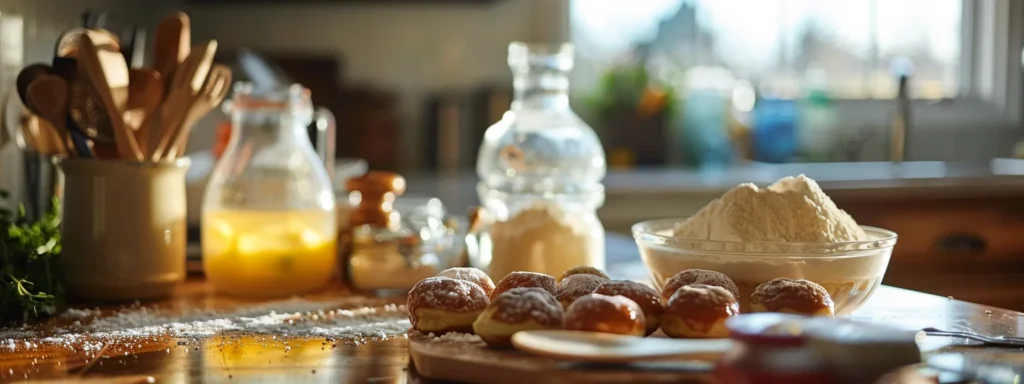
To create delicious homemade glazed donuts, I carefully select essential ingredients that bring both flavor and texture. First, I focus on the type of yeast used, Brothers Bloom which is crucial for achieving that perfect rise. Next, I choose the best flour to create a light and fluffy interior. I also consider adding flavor enhancers to elevate the overall taste. I’ll cover how kosher salt and spatula use can play a role in our dough, and I’ll also touch on the unique characteristics of sourdough for those interested in experimenting.
Essential Ingredients for the Dough
When I prepare the dough for homemade glazed donuts, I prioritize the essential ingredients that contribute to the perfect texture and flavor. White sugar is vital for sweetness, while high-quality flour ensures a light and fluffy donut. Using a mixer helps to combine these ingredients, but a wooden spoon can also effectively bring everything together in a large bowl. The choice of fat—often butter—adds richness, and for frying, I recommend a Dutch oven to maintain the ideal temperature for crispy, golden results.
- White sugar for sweetness
- High-quality flour for texture
- Butter to add richness
- Wooden spoon or mixer for combining ingredients
- Large bowl for mixing
- Dutch oven for frying
Choosing the Right Type of Yeast
When selecting yeast for my homemade glazed donut recipe, I often opt for active dry yeast for its reliability and ease of use. This type can be quickly activated by mixing it with warm water and sugar, ensuring that my dough rises properly. Alternatively, instant yeast can be used for a faster rise without the need for prior activation, which can simplify the process, especially when I’m craving donuts on a busy morning. Choosing the right type of yeast is essential, as it directly impacts the texture and flavor of the finished product, making it a key component in achieving that perfect homemade glazed donut.
Selecting the Best Flour for Texture
When selecting flour for my glazed donuts, I often opt for all-purpose flour due to its balance of protein content, which helps create that desirable texture. For an interesting twist, I sometimes incorporate coconut flour into the mixture. This alternative not only adds a unique flavor but also increases dietary fiber, contributing to a slightly denser yet still delicious result. Proper flour choice significantly influences the frying process, ensuring the donuts remain fluffy and light while achieving that perfect golden crust.
| Flour Type | Texture Impact | Dietary Fiber | Usage Tips |
|---|---|---|---|
| All-Purpose Flour | Light and fluffy | Moderate | Best for classic donuts |
| Coconut Flour | Dense and flavorful | High | Mix with a bit of all-purpose for lightness |
Adding Optional Flavor Enhancers
To add depth and excitement to my glazed donut batter, I often incorporate optional flavor enhancers. For instance, a splash of vanilla extract or a hint of almond flavor can elevate the overall taste. I also consider adding a touch of fresh citrus juice or zest, which not only brightens the flavor but can also introduce calcium if I use dairy-rich ingredients in the glaze, creating a well-rounded donut experience. When I blend these liquid flavorings within the batter, I find they meld beautifully, resulting in a more memorable treat that keeps everyone coming back for seconds.
Prepare the Donut Dough Step by Step
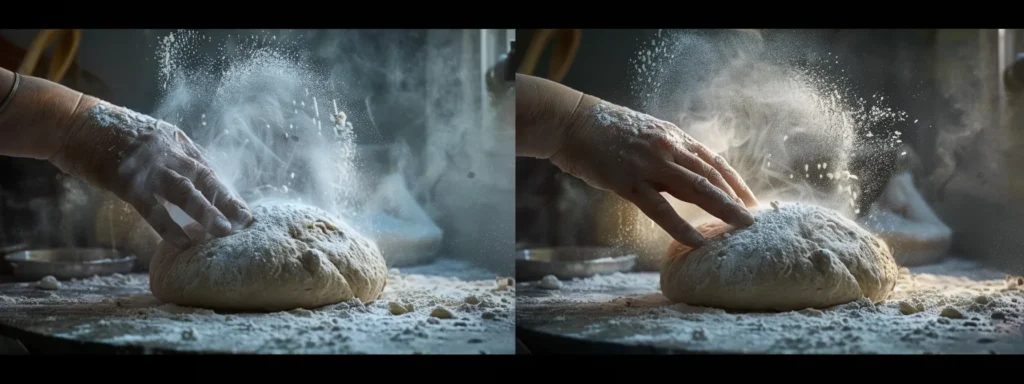
To prepare the donut dough, I start by activating the yeast successfully, ensuring it’s primed for a good rise. Then, I mix and knead the dough properly, focusing on gluten development, before allowing it to rise sufficiently. Shaping the donuts with ease comes next, followed by letting them proof before frying. I always recommend using parchment paper for a smooth transfer to the frying pan for optimal results.
Activate the Yeast Successfully
To activate the yeast successfully, I begin by measuring one tablespoon of sugar and adding it to warm water, which helps feed the yeast. After that, I sprinkle in my active dry yeast and allow it to sit for about 5 to 10 minutes until it becomes foamy, indicating that it’s ready to work. This process ensures that the yeast is alive and viable, setting the stage for a dough that rises optimally, leading to light and fluffy donuts that I can glaze with a rich mixture often enhanced by cream and a dash of cinnamon sugar for flavor.
- Measure one tablespoon of sugar.
- Add it to warm water.
- Sprinkle in the yeast.
- Let it sit for 5 to 10 minutes.
- Wait for foamy appearance, indicating activation.
Mix and Knead the Dough Properly
When I mix and knead the dough for my homemade glazed donuts, I ensure that all the ingredients come together smoothly, integrating the flavors while activating the gluten. I begin by adding the wet ingredients, including almond extracts for flavor, to my dry mixture in a large bowl. Using my hands or a dough hook, I knead the mixture for about 5 to 10 minutes until it becomes smooth and elastic, which is crucial for achieving the right texture. I also pay attention to the calorie and saturated fat content in my ingredients, opting for moderate amounts of fat to keep the donuts delicious but balanced. Ensuring that the dough is correctly mixed and kneaded sets a solid foundation for my donuts to rise beautifully, guaranteeing a delightful treat once they are fried and glazed.
Allow the Dough to Rise Sufficiently
Allowing the dough to rise sufficiently is a key step in making homemade glazed donuts that truly impress. After kneading, I place the dough in a warm, draft-free area, covering it with a damp cloth to maintain moisture. This process typically takes about one hour and is essential for the yeast to activate and create carbon dioxide, which leads to a light and airy texture. I often use a teaspoon of sugar to help nourish the yeast and enhance the taste, while incorporating a splash of apple cider can add a subtle tang that complements the sweetness of the finished donuts. Monitoring the dough closely is important; it should double in size to ensure that my donuts turn out perfectly fluffy, ready for frying and glazing with a rich mixture that respects the ingredient balance, including wheat flour for structure and iron for nutrition.
Shape the Donuts With Ease
When shaping the donuts, I find that using a clean, floured surface helps prevent sticking, ensuring a smoother process. I gently press the dough to about half an inch thick, using a round cutter to create the classic donut shape. If I’m feeling adventurous, I sometimes incorporate spices like cardamom for added flavor, or even a touch of buttermilk to enhance the dough‘s tenderness. This technique allows for uniform donuts that fry evenly, providing that irresistible texture everyone craves:
- Prepare a floured surface for shaping.
- Gently press the dough to half an inch thickness.
- Use a round cutter to make classic donut shapes.
- Consider adding cardamom or buttermilk for extra flavor.
- Ensure uniformity for even frying results.
Let the Donuts Proof Before Frying
Letting the donuts proof before frying is essential for achieving that ideal lightness and fluffiness. I place the shaped dough on a clean surface and cover it with a paper towel to retain moisture while preventing any drafts. This process usually takes about 30 to 45 minutes; during this time, I ensure the environment is warm and free from sodium-heavy ingredients that can inhibit yeast performance. Offering the dough the right conditions to proof can make a significant difference in texture, helping the buns rise properly before hitting the hot oil.
| Proofing Steps | Time Required | Tips |
|---|---|---|
| Cover dough with a paper towel | 30-45 minutes | Keep in a warm area |
| Check for an increase in size | 30-45 minutes | Look for about double the volume |
| Use a whisk to mix any additional ingredients for the glaze | – | Prepare while waiting for proofing |
Create the Classic Glaze and Flavor Variations
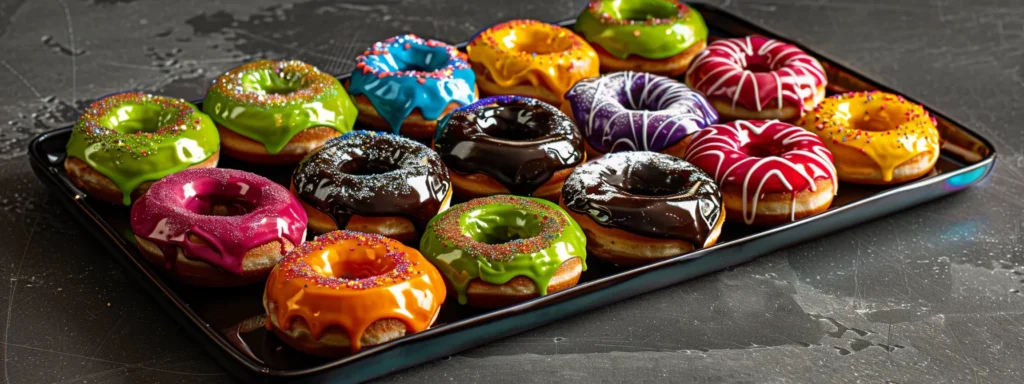
To create the classic glaze for my homemade glazed donuts, I focus on making a standard sugar glaze that has the ideal consistency for dipping. I pay attention to incorporating flavor extracts, which can enhance taste and add uniqueness. Additionally, experimenting with different glaze colors allows for visual creativity, making my donuts even more appealing. As we explore the details, I’ll ensure you understand how to balance carbohydrates and vitamins while keeping the smoke point in mind for frying.
Make the Standard Sugar Glaze
To make the standard sugar glaze for my homemade glazed donuts, I start by combining powdered sugar and a splash of vanilla extract in a bowl. Then, I slowly add warm water or milk, mixing until I achieve a smooth and pourable consistency that clings to the pastries without being too runny. This glaze not only enhances the flavor of the donuts but also provides that signature shiny finish that makes them so appealing.
| Ingredient | Amount | Purpose |
|---|---|---|
| Powdered Sugar | 2 cups | Sweetness and texture |
| Vanilla Extract | 1 teaspoon | Flavor enhancement |
| Warm Water or Milk | 2-4 tablespoons | Consistency adjustment |
Achieve the Perfect Glaze Consistency
To achieve the perfect glaze consistency for my homemade glazed donuts, I find that the right balance of powdered sugar and liquid is essential. I typically start with two cups of powdered sugar and gradually mix in warm water or milk until I reach a smooth, pourable texture that clings well without being too runny. If I’m feeling adventurous, I sometimes add a bit of cream cheese to the mixture for a rich flavor and to create a delightful glaze that complements chocolate chip additions in my donut holes. Proper storage with plastic wrap ensures that any leftover glaze remains fresh for future baking sessions, allowing me to enjoy my creation longer.
Incorporate Flavor Extracts
Incorporating flavor extracts into the glaze for my homemade glazed donuts truly enhances their taste. I often use vanilla extract as my base, but I also experiment with other flavors like almond or coconut to pique interest. Additionally, for a touch of spice, a dash of cinnamon or nutmeg can complement the sweetness of the powdered sugar while adding a layer of depth that elevates the overall experience. These subtle flavor enhancements not only make each bite more delightful but can also introduce a hint of vitamin A from certain dairy ingredients I might use in the glaze.
- Start with a base of vanilla extract for classic flavor.
- Experiment with almond or coconut extracts for uniqueness.
- Add cinnamon or nutmeg for a warm spice sensation.
- Consider the addition of dairy for vitamin A benefits.
Experiment With Different Glaze Colors
Experimenting with different glaze colors adds a fun and visually appealing twist to my homemade glazed donuts. I find that incorporating natural colorants, such as zest from citrus fruits, can brighten the glaze while enhancing flavor; for example, a bit of lemon zest gives a refreshing touch to the classic glaze. Using a measuring cup to precisely mix in food coloring allows for easy adjustments, ensuring I achieve the desired hue without overpowering the taste. Additionally, for a unique flavor experience, I sometimes mix in peanut butter powder to create a creamy, rich glaze that complements the colors beautifully. Ensuring my thermometer is handy when frying helps maintain optimal oil temperatures, contributing to the overall success of my colorful creations.
Fry and Glaze Your Donuts Perfectly
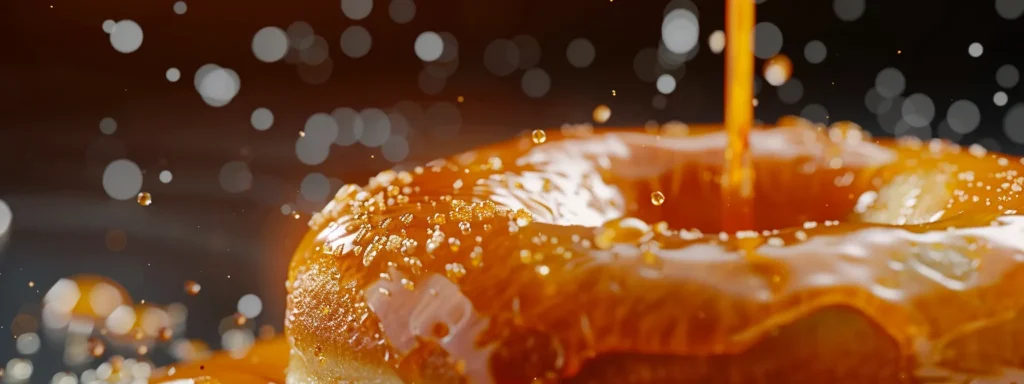
Choosing the right oil for frying is essential for achieving that perfect golden crust on my homemade glazed donuts. I ensure the oil is heated to the optimal temperature for even cooking, creating a delicious, fluffy texture. After frying, I dip each donut in the glaze correctly, ensuring a delightful finish that’s perfect for both classic and chocolate cake variations. In the following sections, I’ll guide you through these crucial steps in detail.
Choose the Right Oil for Frying
Choosing the right oil for frying is essential to achieving the perfect texture and flavor in my homemade glazed donuts. I typically prefer vegetable oil or canola oil because they have high smoke points, allowing the dough to cook evenly without burning. This choice not only ensures a delightful golden crust but also contributes to the overall nutrition of the fried dough. Additionally, I avoid using oils that impart strong flavors, like olive oil, as they can compete with the sweetness of the glaze. Whether I use a frying pan or a slow cooker for frying, ensuring the oil temperature is just right is key to creating that fluffy puff pastry texture everyone enjoys.
Heat the Oil to the Optimal Temperature
Heating the oil to the optimal temperature is essential for frying my glazed doughnuts perfectly. I typically heat the oil in a cast iron skillet, ensuring it reaches around 350°F (175°C) before adding the doughnuts. This temperature allows the doughnut to cook evenly while creating that golden, crispy exterior without absorbing too much oil, which can happen if the oil is too cool or unevenly heated.
| Oil Temperature | Effect on Donuts | Recommended Equipment |
|---|---|---|
| 350°F (175°C) | Golden, crispy exterior | Cast iron skillet |
| Below 325°F (160°C) | Greasy, undercooked doughnuts | Monitor with a thermometer |
| Above 375°F (190°C) | Burnt exterior, raw interior | Cast iron for even heating |
Fry Donuts Evenly and Safely
When I fry my homemade glazed donuts, ensuring they cook evenly and safely is my top priority. I monitor the vegetable oil closely, aiming for a consistent temperature around 350°F (175°C). This optimal heat allows the donuts to achieve a beautiful golden color without absorbing excess fat, which can change the density and texture. Additionally, I use a sheet pan to transfer the fried donuts directly from the oil, minimizing mess and keeping them intact. A sprinkle of nutmeg in the batter not only enhances flavor but also complements the overall experience, resulting in delicious donuts every time.
Dip Donuts in Glaze Correctly
To dip donuts in glaze correctly, I start by ensuring that my glaze is at room temperature for smooth application. I find that holding each donut by the edges allows for an even dip, ensuring the surface is thoroughly coated without over-soaking in the glaze. After dipping, I let any excess drip back into the bowl, often adding a sprinkle of powder flavoring like cinnamon or cocoa for added taste before the glaze sets, elevating the overall flavor profile of my homemade glazed donuts. This technique not only enhances presentation but also ensures my donuts maintain their delightful texture while providing that irresistible sweetness that keeps everyone coming back for more.
Troubleshoot and Perfect Your Donut-Making Skills
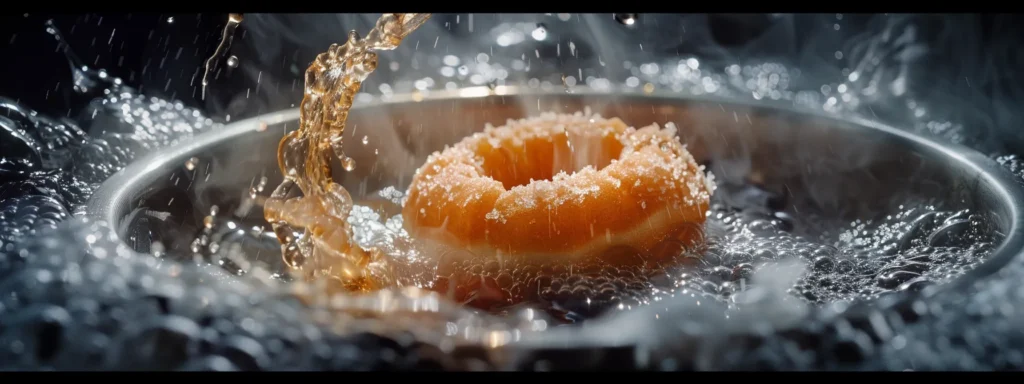
In this section, I focus on how to troubleshoot common issues in homemade glazed donut preparation. I’ll highlight ways to avoid common mistakes that can lead to unsatisfactory results. If you ever find your donuts are dense or greasy, I’ll provide solutions to fix these problems. Additionally, I’ll share tips for achieving a truly fluffy texture and guidance on adjusting the recipe for specific dietary needs.
Avoid Common Mistakes
To perfect my homemade glazed donuts, I focus on avoiding common mistakes that can lead to disappointing results. One frequent error is not allowing the dough to rise sufficiently; this can result in dense donuts that lack the desired light and fluffy texture. Additionally, frying the donuts at the wrong temperature can cause them to become greasy or too dark, negatively affecting flavor and appearance. Understanding these pitfalls helps me create a more enjoyable treat:
- Ensure proper rising time for lightness.
- Monitor oil temperature to avoid greasiness.
- Use quality ingredients to enhance flavor.
- Shape donuts evenly for consistent frying.
- Let the glaze set properly to enhance texture.
Fixing Dense or Greasy Donuts
If I find that my homemade glazed donuts are dense or greasy, I take a moment to assess where things might have gone wrong. For dense donuts, I ensure that the yeast was properly activated and that the dough had adequate rising time, allowing those gases to create the light texture I aim for. To combat greasiness, I double-check the frying oil temperature, making sure it stays around 350°F (175°C) for even cooking; this helps achieve that perfect golden crust without soaking up excess oil:
- Ensure yeast activation by checking for foamy consistency.
- Allow sufficient rising time for dough to become airy.
- Monitor frying oil temperature to avoid greasy results.
- Fry donuts in small batches to maintain oil temperature.
- Adjust frying time for lightness and golden color.
Tips for Achieving a Fluffy Texture
To achieve a fluffy texture in my homemade glazed donuts, I closely monitor the rising time of the dough. Ensuring that the dough doubles in size is crucial, as this indicates that the yeast has effectively worked to create air pockets. Additionally, when I knead the dough, I focus on developing the gluten properly; this strengthens the dough and helps it maintain its airy structure during frying, resulting in light, tender donuts every time.
Adjust the Recipe for Dietary Needs
When adjusting my homemade glazed donut recipe for dietary needs, I find it essential to substitute ingredients without compromising flavor and texture. For those looking for gluten-free options, I often replace all-purpose flour with a blend of gluten-free flours, ensuring that the balance of moisture is maintained for a light result. For a healthier twist, I might use unsweetened applesauce instead of butter or oil, which not only reduces calories but also keeps the donuts moist, appealing to those mindful of their dietary choices.
Enjoy and Store Your Homemade Donuts
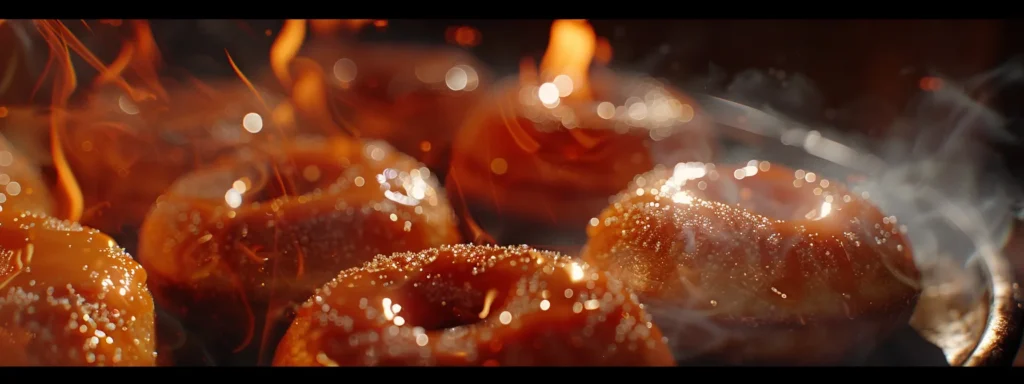
To enjoy my homemade glazed donuts at their best, I always serve them fresh to highlight their delightful texture and flavor. For any leftovers, I make sure to store them properly to maintain quality. Additionally, I’ll share how to reheat the donuts without losing their deliciousness, ensuring each bite remains satisfying even after a day.
Serve Donuts for Maximum Freshness
When serving my homemade glazed donuts, I always prioritize freshness to enhance the delightful experience for my guests. I find that presenting the donuts warm, right after glazing, creates that perfect, melt-in-your-mouth moment that everyone loves. To maintain their quality, I store any leftovers in an airtight container, ideally at room temperature, to prevent them from becoming stale, ensuring that each bite remains enjoyable even the next day.
Store Leftovers Properly
To ensure my homemade glazed donuts stay fresh, I store them in an airtight container at room temperature. This method helps retain their delightful texture and flavor while preventing them from becoming stale. If I want to keep them for a longer period, I freeze the donuts in individual portions, wrapping each one in plastic wrap before placing them in a freezer-safe bag. This way, I can enjoy a warm, freshly glazed donut whenever the craving strikes, without compromising quality.
Reheat Donuts Without Losing Quality
When I reheat my homemade glazed donuts, I focus on maintaining their delightful texture and flavor. I find that the best method is to use an oven set at a low temperature, around 350°F (175°C), which warms the donuts evenly without making them too dry. By wrapping each donut in foil, I can preserve moisture and ensure they come out warm, soft, and delicious, just like when they were freshly made.
Conclusion
Creating an easy-to-follow homemade glazed donut recipe allows anyone to enjoy the deliciousness of fresh donuts right from their kitchen. Selecting quality ingredients such as yeast, flour, and flavor enhancers is crucial for achieving the perfect texture and taste. By mastering the step-by-step process, including proper dough preparation and glazing techniques, you can elevate your baking skills and impress family and friends. Embrace the joy of making your own donuts and savor the satisfaction of enjoying a warm, homemade treat that will keep everyone coming back for more.

